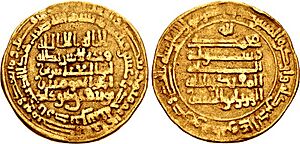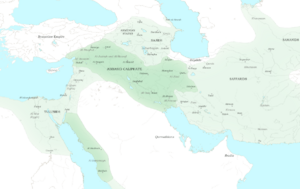Abu'l-Hasan Ali ibn al-Furat facts for kids

Abu'l-Hasan Ali ibn al-Furat (Arabic: أبو الحسن علي بن محمد بن الفرات; 855 – 18 July 924) was a very important official in the Abbasid Caliphate. He worked as a vizier (like a prime minister) three times for Caliph al-Muqtadir.
Ali ibn al-Furat became well-known because he was good at managing money for the government. He led one of the two main groups of officials in the Caliph's court. This group was called the Banu'l-Furat. The other group was led by the military commander Mu'nis al-Muzaffar and another vizier, Ali ibn Isa al-Jarrah.
Ali played a big part in choosing al-Muqtadir as Caliph in 908. During his first time as vizier (908–912), he helped bring the Fars region back under the Caliphate's control. He also made the Sajid rulers of Adharbayjan respect the Caliph's authority again.
He served as vizier a second time in 917–918. After this, he was put in prison by the next vizier. He was set free in 923 and became vizier for the third and last time. However, he was very harsh towards his rivals. Also, the government faced problems with the Qarmatians, a group that attacked cities. These issues led to his removal and execution on 18 July 924. His son, al-Muhassin, was also executed.
Contents
Life of Ali ibn al-Furat
Ali's family was already important in Baghdad in the early 800s. His father, Muhammad ibn Musa, was the first in the family to hold a major government job. Ali started his career with his brother, Ahmad. This was during the later years of Caliph al-Mu'tamid (870–892).
Both brothers were supported by Isma'il ibn Bulbul, who became vizier in 885. He brought them into the government because they were experts in money matters. They managed the land tax department for the Sawad region.
When al-Mu'tadid became Caliph in 892, Ali's brother Ahmad was put in charge of all land tax departments. Ali worked as his assistant.
Rival Groups in Government
The Ibn al-Furat brothers and their supporters became one of the two main groups in the Abbasid government. They were known as the Banu'l-Furat or Furatids. Their main rivals were another group of officials, the Banu'l-Jarrah or Jarrahids. This group was led by Ali ibn Isa al-Jarrah.
These two groups were always competing for power and important jobs. The Banu'l-Jarrah often hired Christians in the government and were closer to the military. The Banu'l-Furat wanted the civilian government to have strong control over the army. They also secretly favored Shi'ism, a branch of Islam.
The competition between them was tough. When an official lost their job, they often had to return money they were accused of taking. This system was called muṣādara. It sometimes forced officials to take money while in office so they could pay it back later.
Becoming Vizier
Ali and his brother continued to work in the tax departments under Caliph al-Muktafi (902–908). After his brother died in 904, Ali became the chief helper to the vizier, al-Abbas ibn al-Hasan al-Jarjara'i.
When al-Muktafi died in 908, there was no clear successor. The vizier al-Abbas asked important officials for advice. Ali suggested choosing al-Muktafi's 13-year-old brother, Ja'far. They thought Ja'far would be easy for the officials to control. This young ruler became Caliph al-Muqtadir (908–932).
Choosing such a young Caliph was a bad sign. Historian Hugh N. Kennedy said it led to "one of the most disastrous reigns" in Abbasid history. It undid much of the good work done by earlier Caliphs. After a failed attempt by others to take over, Ali was made vizier on 19 December 908.
First Time as Vizier (908–912)
During his first time as vizier, Ali had almost complete power. Only a few palace officials, the Caliph's mother, and some court eunuchs could challenge him.
He had some big successes. He helped the Caliphate regain control of the Fars region. He also made the Sajid ruler of Adharbayjan, Yusuf ibn Abi'l-Saj, accept the Caliph's authority. In return, Yusuf paid a small yearly tribute of 120,000 dirhams (a type of coin). Yusuf was so grateful that he saw Ali as his protector and even put Ali's name on his coins.
However, Ali started to misuse his power. He took large amounts of money from the government treasury. Because of this, he was fired and arrested on 21 July 912. Muhammad ibn Ubayd Allah al-Khaqani took his place.
Second and Third Times as Vizier
Ali was made vizier again on 3 June 917. He replaced his old rival, Ali ibn Isa. But his second time as vizier was difficult. Yusuf, the ruler of Adharbayjan, stopped paying tribute to Baghdad. He also took over some areas in Iran. Ali tried to help Yusuf, but it didn't work. Ali was dismissed in November 918. Yusuf was later defeated and brought to Baghdad as a prisoner by the army commander, Mu'nis al-Muzaffar.
Ali remained in prison in the Caliph's palace. He was released only after the next vizier, Hamid ibn al-Abbas, was dismissed in 923. Ali was then appointed vizier for the third and final time on 7 August 923.
Ali's last time as vizier (August 923 to June 924) is seen by historians as a very bad period. Instead of being kind to his rivals, Ali and his son, al-Muhassin, took revenge on anyone who had wronged them. They used force to get large sums of money from officials. To make himself even stronger, Ali sent the powerful commander Mu'nis al-Muzaffar away from Baghdad.
The government's power also weakened because of new attacks from the Qarmatians. They attacked the city of Basra in 923. They also destroyed a group of Hajj pilgrims returning from Mecca in April/May 924. Ali could not stop these attacks, and his popularity dropped. This led to riots in Baghdad.
His harshness made other officials angry. The government also ran out of money and could not pay the army regularly. This put more pressure on the Caliph. Finally, in early June 924, Caliph al-Muqtadir had Ali and his son arrested. The Caliph still respected Ali's intelligence. But when Ali and his son were brought to trial, Ali was rude. So, Ali and al-Muhassin were executed on 18 July 924.
After Ali, his nephew al-Fadl managed to get important jobs after 927. He even served as vizier for short times in 932 and 937.
What Was Ali ibn al-Furat Like?
Ali ibn al-Furat was a complex person. He was very educated and cultured. He was intelligent and spoke very well. He was known as an excellent financial manager. Historian Hugh Kennedy said he wanted to "reform abuse and raise state revenues without oppression." Dominique Sourdel noted he could "solve rapidly what appeared to be the most complicated problems."
He lived like a "grand seigneur," enjoying luxury. He also gave a lot of money to his followers to make himself look good. However, his main goal was to benefit himself and his followers, not necessarily the state or the Caliph. He was part of a group that was almost like a secret political party. Even though he fought corruption in others, he sometimes broke the law for his own gain. Kennedy described him as "ruthless and unscrupulous when it came to furthering his own interests."
| Preceded by al-Abbas ibn al-Hasan al-Jarjara'i |
Vizier of the Abbasid Caliphate 19 December 908 – 21 July 912 |
Succeeded by Muhammad ibn Ubayd Allah al-Khaqani |
| Preceded by Ali ibn Isa al-Jarrah |
Vizier of the Abbasid Caliphate 3 June 917 – 17 November 918 |
Succeeded by Hamid ibn al-Abbas |
| Preceded by Hamid ibn al-Abbas |
Vizier of the Abbasid Caliphate 7 August 923 – 15 June 924 |
Succeeded by Abdallah al-Khaqani |


